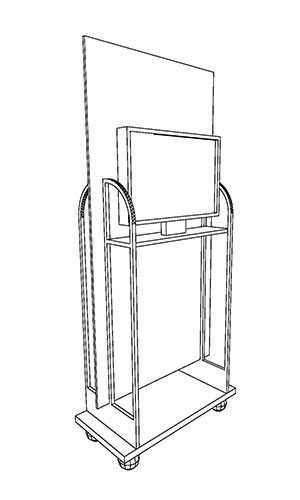
Start with a basic fixture, designed for flexibility and mobility.
Authors note: Original article is written for and posted in the Ennco Blog. You might want to check them out, or just read it here.
Helping Retailers Succeed – Most every year the Small Business Development Center, in my case locally in Virginia, puts on an event designed to help retailers succeed. I usually attend. This year’s event was The Alexandria Experiential Retail Summit, experiential being the operative word. Most of the discussion centered around primary marketing and selling communications, which are important, but only indirectly relevant to the design of a physical store.

Make an impact with a product specific, in this case eye wear, or lifestyle graphic.
Demonstating Knowledge – Interestingly, when we broke into discussion groups more significant design issues were revealed. In particular the need for flex space. Retailers are finding it necessary to become experts. Clients expect them to be masters of their particular product or service and further customers prefer to see this knowledge demonstrated, to the extent that a retailer must often become an educator. One such resort type fashion retailer wanted to offer a mini class on how a particular brand of scarf might be worn to best advantage. She assumed that this was impossible as she was “out of space” in her shop.
Retailers Sometimes Need Reminding – Clearly retailers occasionally need reminding that almost all floor fixtures can be mobile and mobility frees up valuable retail space within a store. Simply by adding casters and rolling away some regular floor fixtures this owner, hoping to demonstrate how to tie her line of scarves, could easily free up enough space to stage and event featuring her product.
Invest in a Starter – Another, not to be overlooked, design issue is flexibility. Indeed, there is a need for a highly adaptive store fixture suitable for use in many varied sets of circumstances, including options for accommodating the all important media. This one is able to accommodate everything from a continuous video in a loop, to presentation options used to enhance a demonstration, to a basic TV in a waiting area. It has vertical standards that can be used for shelving, a platform base for a computer, if required, and a simple backdrop made of glass or other merchandise display material like pegboard. In addition to all this it is two sided, mobile, and has space to hide most cables. It is a great starter for any retailer wanting to incorporate media and create that “WOW“ moment.
Bridget Gaddis, is a Licensed Architect and LEED Accredited Professionnal practicing nationally, and locally in the Washington DC area. She holds professional degrees in both Architecture and Interior Design and has a comprehensive background in commercial retail design, planning and construction. She has many years experience working for well known architects, developers and retailers. In 2011 she started Gaddis Architect an independent practice in Alexandria, VA. In addition, Ms. Gaddis has an interest in residential projects and is the author of “Real People Don’t Hire Architects,” a blog about houses.
